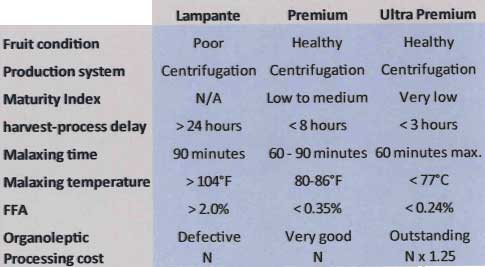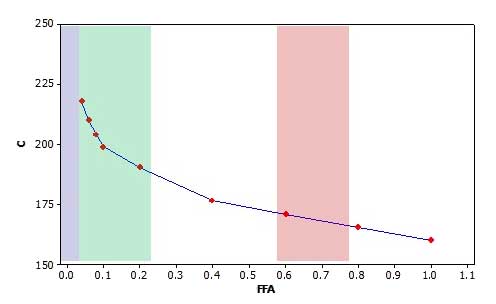Conversion Chart
| Butter/Margarine | Olive Oil |
|---|---|
| 1 teaspoon | 3/4 teaspoon |
| 1 tablespoon | 2 1/4 teaspoons |
| 2 tablespoons | 1 1/2 tablespoons |
| 1/4 cup | 3 tablespoons |
| 1/3 cup | 1/4 cup |
| 1/2 cup | 1/4 cup + 2 tablespoons |
| 2/3 cup | 1/2 cup |
| 3/4 cup | 1/2 cup + 1 tablespoon |
| Extra virgin olive oil decreases in flavor and health benefits over time. Fresh crushed olive oil is like fresh squeezed fruit juice in that it contains the most flavor and nutrients. Old, poorly made and improperly stored extra virgin olive oil yields fewer if any health benefits and undesirable flavor. |
| Becoming intimately familiar with a particular extra virgin olive oil's flavor characteristics and chemistry i.e. antioxidant content, oleic acid, FFA, and crush date will help you make an educated decision about which olive oil is right for you. |
| Crucial Olive Oil Chemistry Definition Key |
| Oleic Acid: is a monounsaturatedomega-9fatty acidfound in olive oil. Olive oil is generally higher in oleic acid than other vegetable fats. The range found in extra virgin olive oil is between 55-85%. Extra virgin olive oil high in oleic acid has greater resistance to oxidation. |
| FFA: (Based on IOOC Standards) the maximum limit for free fatty acid in extra virgin olive oil is 0.8g per 100g or (.8%). A low FFA is desirable. Free fatty acid speaks to the condition of the fruit at the time of crush. The higher the FFA the greater the indication of poor quality fruit such as damaged, overripe, insect infestation, overheating during production or too much of a delay between harvest and crush. |
| Peroxide Value: (Based on IOOC Standards) the maximum peroxide value for extra virgin olive oil is 20. A very low peroxide value is desirable. Unsaturated free fatty acids react with oxygen and form peroxides, which create a series of chain reactions thatgenerate volatile substances responsible for a typical musty/rancid oil smell. These reactions are accelerated by high temperature, light, and oxygen exposure. |
| Polyphenol Count: Polyphenols are a class of antioxidants found in a variety of foods. Polyphenols such as Oleuropein, Oleocanthal,and hydroxytyrosolimpart intensity connected with pepper, bitterness and other desirable flavor characteristics. Recent studies indicate that these potent phenols are responsible for many of the health benefits associated with consuming fresh, high quality extra virgin olive oil. Phenols in olive oil decrease over time or when exposed to heat, oxygen and light. Consuming fresh, well-made olive oil with high polyphenol content is crucial when looking to obtain the maximum healthbenefit commonly associated with consuming extra virgin olive oil. |
| New Testing Methods Based on Olive Oil Chemistry |
| DAGs Test/Score: Measures the proportion of two forms of diacylglycerol: 1,2 and 1,3. In oil freshly made from sound olives of good quality, the prevalent form of DAG is the 1,2 form where the fatty acids are bonded to a glycerol molecule in the 1 and 2 positions. The bond on the 2 position is weak and easily broken, leading to the migration of that 2 position fatty acid to the 3 position. This results in the much more stable 1,3 DAG. This makes the ration of 1,2 DAGs to the total DAG’s a good indicator of the quality of the olive fruit and the processing. It is also an indicator of the age of an oil, since the migration from 1,2 to 1,3 DAGs takes place naturally as the oil ages. Warmer storage temperatures, and higher free fatty acid levels will both accelerate this process, but DAGs are not affected by the short exposure to high heat that is characteristic of deodorizing (refining). |
| PPP Test/Score: This test was developed to measure the degradation of chlorophyll in olive oil. This degradation of chlorophylls to pyropheophytin was found to take place at a predictable pace, making it possible to gain information about the age of an olive oil. The rate at which the degradation occurs can be accelerated by even short periods of high temperatures – such as that which is utilized during the deodorizing or soft column refining process –making it a useful indicator of the presence of deodorized olive oil as well as the age of the oil. |
| (Information provided by Veronica Foods Company) |
| Are All Olive Oils The Same? |
 |
| Maturity Index |
 |
| Smoke Point Of Extra Virgin Olive Oil |
| The smoke point of any edible oil depends a lot on the free fatty acidity (FFA or acidity) of the oil. The lower the acidity the higher the smoke point. All refined oils such as canola, vegetable, sunflower, peanut, flaxseed, rice bran etcetc have pretty well close to zero acidity as the refining process removes all of the free fatty acids.‘Pure olive oil’, ‘Light olive oil’ and ‘Olive oil’ are also refined and as such they smoke at a respectable 230C. On the other hand, Extra virgin olive oil is a natural product and as such its acidity varies greatly from brand to brand. Some carefully made artisan oils have acidities as low as 0.07%, but a good EVOO will typically come in around 0.2 to 0.25%. However, your typical inexpensive supermarket extra virgin olive oil from the EU will probably be around 0.5% acidity with some even nudging the comical International Olive Council limit of 0.8%. These seemingly small differences in acidities actually have a significant influence on the temperature at which the oil will begin to smoke. The following diagram shows the influence of FFA on the smoke point of an extra virgin olive oil. The green band shows the smoke point range of good quality low acidity extra virgin olive oil. The reddish band shows the smoke point of lower quality high acidity oils. In culinary terms, these real differences are huge! |
 |
| OUR BALSAMIC CONDIMENTO FROM MODENA ITALY |
| We refer to our dark balsamic as “Traditional Style Condimento, Aged Up to 18 Years”. Our dark condimento is of the highest quality and is made in Modena, Italy from cooked, high quality caramelized grape must from Trebbiano and Lambrusco grapes. The grape must in our Condimento is cooked over an open wood fire, just as DOP Traditional Balsamic grape must is. It is cooked down to the same consistency, density and dry solid extracts, actually. DOP Traditional Balsamic dictates that wood-fire-cooked grape must is then put directly in to old, fired wood barrels which were used to age balsamic in years past. These barrels become progressively smaller as the product becomes thicker and naturally evaporates over time. The barrels as well as the product they once contained, add character to the must over time. Nothing is ever added to the cooked, caramelized must of DOP balsamic. Pro-biotic wild yeast and acetic bacteria colonize it and eventually raise the acidity. It slowly ages in this manner and turns in to "vinegar" by itself over the course of many years, hence the scarcity and price tag. |
| By Italian law, DOP balsamic must then undergo strenuous sensory evaluation as well as laboratory analysis which measures extensive criteria including and most importantly, dry extract solids. Once approved as DOP, it can then only be sold in 100 ml. bottles which are identical based on two exclusive regions of production, Emilio Reggiano or Modena Italy. The bottles from each region are uniform in size and shape regardless of who produced the balsamic. The consortium then licenses the producer to use the 100 ml. DOP bottle which is then, wax sealed, numbered and boxed for individual sale. The wax sealed numbered bottles will never be sold unboxed, as a loose bottle by itself. Furthermore, it is never, sold in other types of bottles outside of the 100ml. DOP bottle, and certainly never in bulk, EVER! Furthermore, this product is rarely if ever used for cooking. It is far too prized and expensive. For this reason, it’s typically served drop by drop on a spoon, like a digestive after a meal. We urge you to open a tiny wax sealed and numbered bottle of DOP balsamic and compare it with our Traditional Style Balsamic Condimento of Modena, Italy. The similarity is remarkable. |
| The primary difference between DOP Balsamic and our condimento is that out of the gate our Condimento is inoculated with a very small amount of premium quality, barrel aged Italian wine vinegar. The barrel aged wine vinegar introduces the natural acetic bacteria and yeast and begins the process from cooked grape must to “condimento”. It is then aged using the Solera method which dictates that it be placed in a succession of different types of very old, fired wood barrels, each of which previously contained residual amounts of older balsamic dating back as far as 18 years and in some cases 25 years. It’s topped off as it moves from barrel to barrel, based on the Solera method, and with younger, wood fire cooked grape must as it naturally evaporates. For this reason, no product except actual DOP certified balsamic in licensed 100 ml. bottles can make an actual age claim - ever! However, you can accurately and confidently say that our product has been “aged for up to 18 years” if you would like to mention age at all. However, age is not a criterion of quality. |
| As with DOP balsamic, our condimento’s very low acidity of 4% is a function of the grape must being naturally cooked down, condensed, caramelized and aged without the addition of much else, unlike so many “balsamic-like” products on the market which are not from Modena and are comprised almost wholly of poor quality wine or distilled vinegar, thickeners, color and sweeteners. The density and complexity of our condimento are a testament to the fact that it is made in Modena in the Solera method from high quality grape must, cooked down over an open wood fire. Its’ very high level of dried extract solids is close to if not identical to that of DOP Traditional Balsamic sold exclusively in 100ml. bottles. |




